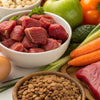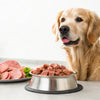A Comprehensive Guide on How to Feed My Dog a Raw Food Diet
- Houndsy
Table of Contents
- Introduction
- Understanding Raw Dog Food Diets
- Balancing Nutrients in a Raw Diet
- Safety and Handling Guidelines
- Transitioning Your Dog to a Raw Food Diet
- Incorporating Houndsy Products into Raw Feeding
- Conclusion
- FAQ Section
Introduction
Did you know that the raw food diet for dogs has gained significant traction, with approximately 25% of dog owners incorporating raw meat into their pets' meals? As we learn more about pet nutrition, many of us are increasingly interested in how to feed our dogs a raw food diet that meets their ancestral dietary needs. This movement is not just a trend; it's a lifestyle choice that reflects our desire to provide our furry friends with the most nutritious and wholesome food possible.
Transitioning to a raw diet can be a daunting task for many dog owners. We worry about the balance of nutrients, the possibility of choking on bones, and the overall safety of feeding a raw diet. However, with thoughtful planning and the right resources, we can eliminate those fears and ensure our dogs receive the health benefits that come with a properly managed raw food diet.
In this blog post, we will explore the essentials of feeding your dog a raw food diet. We will cover the benefits of this diet, the necessary balance of nutrients, how to select the right ingredients, tips for safe feeding practices, and how to make the transition seamless. By the end, you'll have a grounded understanding of how to effectively transition your dog to a raw food diet, while considering their unique needs.
So, if you've ever wondered how to feed your dog a raw food diet, let’s embark on this journey together!
Understanding Raw Dog Food Diets
What is a Raw Food Diet for Dogs?
A raw food diet, often referred to as RMBD (Raw Meat-Based Diet), consists primarily of uncooked meat, bones, organs, and supplemented by fruits and vegetables. This diet seeks to mimic what dogs would eat in the wild, prioritizing natural ingredients devoid of fillers and artificial preservatives.
The Rise in Popularity
In recent years, the trend for feeding dogs a raw diet has seen a dramatic rise, with sales increasing by at least 15% annually. More pet owners are looking for quality over quantity, opting for foods that are free from synthetic ingredients.
Key Benefits of a Raw Diet
- Healthier Coat and Skin: Many pet owners report shinier coats, healthier skin, and improved vitality in their pets.
- Better Digestive Health: Raw diets tend to improve digestion due to higher moisture content and natural enzymes found in raw food.
- Weight Management: Portion control is more effective with raw feeding, which often leads to more optimal weight maintenance.
- Reduced Allergies: A raw diet can help alleviate allergy symptoms in some dogs that have sensitivities to common pet food ingredients.
These benefits contribute to the increasing awareness among pet owners regarding the potential advantages of adopting a raw food regimen.
Balancing Nutrients in a Raw Diet
Essential Elements of the Raw Diet
When transitioning to a raw food diet, we must ensure it is well-balanced. A raw diet should primarily consist of the following components:
- Proteins: Meat should be the cornerstone of a raw dog's diet. This can include beef, chicken, lamb, fish, and even organ meats. High-quality proteins are key to providing essential amino acids.
- Fats: Fats should make up about 10% to 20% of your dog’s diet. Healthy fat sources include fish oil or fatty cuts of meat.
- Bones: Raw bones are rich in minerals and provide a source of calcium. Approximately 10% to 15% of a dog’s diet should include bone.
- Fruits and Vegetables: While not essential, these can offer additional vitamins and act as an antioxidant source. Common choices are carrots, apples, and spinach.
Achieving a Proper Balance
To ensure that your dog receives a balanced diet, we need to pay attention to the ratios. A typical guideline is as follows:
- 70% meat (including organ meat)
- 10% bones
- 20% fruits and vegetables
This balance provides essential nutrients that contribute to overall health and well-being.
Safety and Handling Guidelines
Safe Practices for Feeding Raw
Feeding raw comes with its own set of safety rules. Here are some essential practices for safe meal preparation and serving:
- Hygiene: Always wash your hands before and after handling raw meat. Clean and disinfect surfaces and dishes to prevent cross-contamination.
- Storage: Store raw meat in the refrigerator or freezer. Ensure that it's contained to prevent any splashes or drips that could lead to contamination.
- Time Management: Serving raw food quickly helps maintain freshness. Avoid letting raw food sit out at room temperature for longer than necessary.
Implementing these practices not only ensures the health of your pet but also the well-being of your family members.
Choosing the Right Ingredients
Select high-quality ingredients to create a nutritious and safe raw dog food diet. Some points to consider include:
- Sourcing: Use fresh, reputable sources for meat. Pasture-raised or grass-fed animals may contain higher nutritional values.
- A Variety of Proteins: Rotate protein sources to prevent allergies and ensure a well-rounded nutrient profile.
- Consult with Experts: If you’re unsure about your dog’s dietary needs, consulting a veterinarian or pet nutritionist can provide personalized recommendations.
Transitioning Your Dog to a Raw Food Diet
Step-by-Step Transition Guide
Transitioning to a raw food diet should be done gradually to allow your dog’s digestive system to adapt. Here’s a simple plan to follow:
- Start Slowly: Begin by introducing small portions of raw food into your dog's current diet. This could be as simple as substituting one meal a week with raw food.
- Monitor Reactions: Watch for any changes in your dog’s digestive health, behavior, and energy levels. If any issues arise, slow down the transition.
- Gradually Increase Raw Portions: Over the next week or two, slowly increase the raw food ratio while decreasing commercial food.
- Complete the Switch: Once your dog is well-adjusted, you can completely transition to a raw diet.
Addressing Common Concerns
Many dog owners have fears regarding raw diets, which are entirely valid. Let’s address some common worries:
- Choking Hazards: Providing appropriately sized bones, overseeing your dog while they eat, and selecting softer meat can mitigate choking risks.
- Nutritional Balance: Working with a veterinarian or nutritionist can help ensure that your dog’s diet is well-balanced and meets their nutritional requirements.
- Foodborne Illness Risks: Following proper hygiene, sourcing quality ingredients, and understanding the risks associated with feeding raw can alleviate these concerns.
By preparing thoughtfully and progressing gradually, we can promote a seamless transition for our dogs.
Incorporating Houndsy Products into Raw Feeding
As we strive to provide our dogs with the best possible feeding experience, we at Houndsy recognize how vital it is for pet owners to have convenient solutions that facilitate feeding routines. While managing a raw food diet, having the right tools like the Houndsy Kibble Dispenser can simplify daily servings while keeping your pet's meals organized and fresh.
Our Houndsy Kibble Dispenser is designed for convenience, allowing for precise portion control and maintaining food quality with an auto-locking mechanism. The attractive mid-century modern design seamlessly fits into any home, ensuring that your dog’s feeding station is as visually pleasing as it is functional.
Conclusion
Feeding your dog a raw food diet can promote better health and improve their quality of life when done properly. Through understanding the essentials of balancing nutrients, ensuring safe practices, and transitioning slowly, we can make this dietary shift a positive experience for our furry companions.
By considering the unique needs of your dog, sourcing high-quality ingredients, and adopting structured feeding practices, we can create an optimized raw food regimen that suits both our lifestyles and their nutritional requirements.
Whether you’re already on the path of raw feeding or just contemplating the switch, remember that you are not alone. With resources like Houndsy’s innovative products and a community of supportive pet owners, we can take charge of our dogs' diets in a way that is both enriching and enjoyable.
If you have further questions or are looking to streamline feeding routines with our innovative solutions, check out the Houndsy Kibble Dispenser today!
FAQ Section
Is a raw food diet safe for all dogs?
While many dogs thrive on a raw food diet, it may not be suitable for all pets. Dogs with certain health conditions or specific dietary needs may require a different approach. Always consult with your veterinarian before making significant changes to your dog's diet.
How do I know if my dog is getting a balanced raw diet?
To achieve a balanced diet, ensure you include a variety of proteins, a proper ratio of bones for calcium, and some fruits and vegetables. Working with a pet nutritionist can help tailor a raw diet suited to your dog’s individual health needs.
Can I feed my dog bones?
Yes, you can feed your dog bones, but they should be raw and non-weight bearing bones from healthy animals. It’s important to supervise your dog while they eat bones to ensure safety.
What signs should I look for that my dog is adjusting well to a raw diet?
Improved coat condition, stable energy levels, regular bowel movements, and overall well-being are positive indicators that your dog is adjusting well to a raw food diet. If you notice any adverse effects, consult a veterinarian.
Are there any risks associated with feeding raw?
Yes, there can be risks such as bacterial contamination and nutritional imbalances. This is why it is crucial to source high-quality ingredients and follow best practices for hygiene and meal preparation.
Remember to embrace this feeding journey together with your dog, and don't hesitate to reach out to the community for support!












